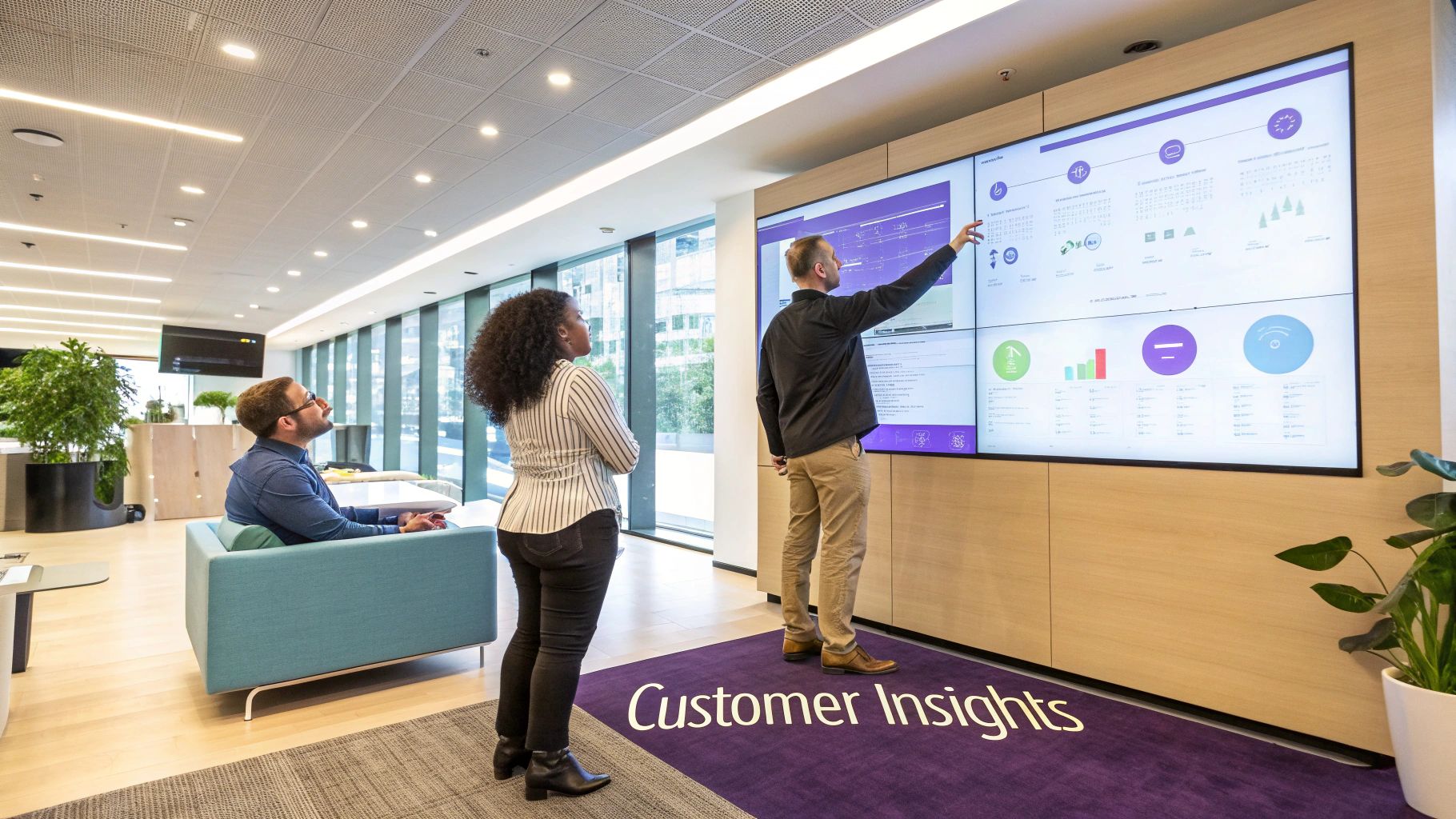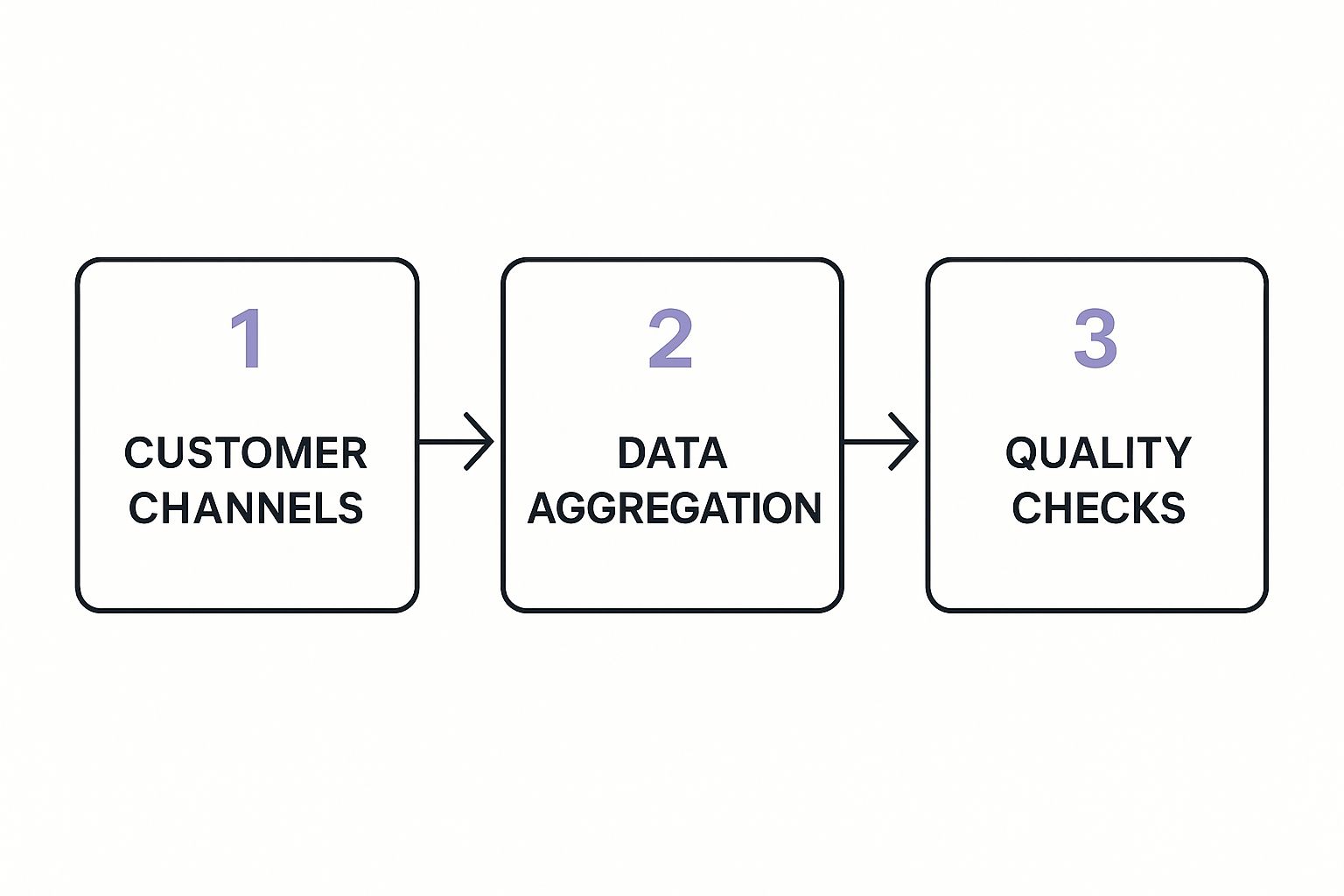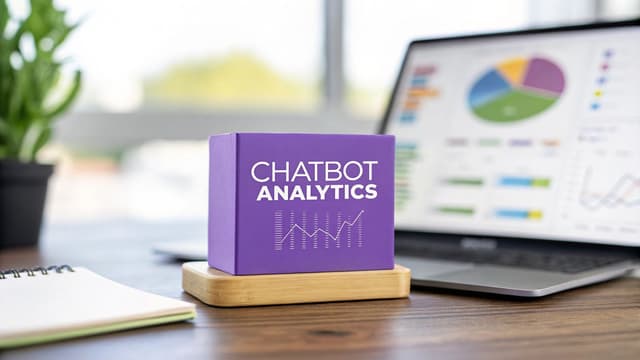Why Most Companies Miss The Real Conversation

This screenshot shows a Salesforce Service Cloud Analytics dashboard. Notice how it highlights metrics like case resolution time and agent performance. These visuals give a quick overview of what's happening in customer service. It's like a snapshot, helpful for spotting key performance indicators and areas for improvement.
But imagine trying to understand a movie just by looking at the poster. You get a basic idea, but you miss the whole story. Traditional customer feedback, like surveys, is similar. They offer surface-level impressions, but lack depth. This is where customer interaction analytics comes in.
It's like diving into the actual dialogue of the movie. It explores every customer touchpoint and reveals the why behind customer actions. Instead of just knowing a customer left, you understand the frustrating conversations that led to their departure.
This allows businesses to step in before problems get bigger, shifting from reactive customer service to proactive relationship building.
Beyond Basic Metrics: Uncovering the Real Story
Traditional analytics often focuses on metrics like CSAT (customer satisfaction scores) and NPS (Net Promoter Scores). These are valuable, but they capture a delayed reaction, a snapshot after the experience.
Customer interaction analytics lets businesses listen to the real-time conversation happening across all channels. It's not just what customers say, but how they say it. Analyzing tone, sentiment, and even specific words reveals frustration, excitement, or confusion, providing a far richer understanding.
The Growing Importance of Conversation Intelligence
The focus on understanding customers deeply is reflected in the growth of the customer analytics market. It jumped from $10.5 billion in 2020 to an estimated $24.2 billion by 2025. That's a compound annual growth rate (CAGR) of almost 18%. Learn more about customer analytics market growth here
This growth shows how much businesses value deep customer understanding. Plus, AI-powered tools like FlowGent AI are making these sophisticated analyses accessible to companies of all sizes. Now, businesses can move beyond simply collecting data to truly understanding the "why" behind customer behavior and using those insights to make real improvements.
The Building Blocks of Analytics That Actually Matter
Forget trying to capture every single piece of data. Effective customer interaction analytics is about focusing on the key moments that truly reveal what customers are thinking and feeling. It’s like a detective solving a case – they don't need every scrap of evidence, just the crucial clues that crack the mystery. Top-performing companies combine three core elements to transform raw conversation data into valuable business insights.
Emotion Detection: Reading Between the Lines
First, emotion detection goes beyond simply labeling interactions as "happy" or "sad." It digs deeper to identify subtle shifts like rising frustration, urgent needs, and moments of genuine satisfaction. Imagine a customer calling about a late delivery. Basic sentiment analysis might flag this as "negative." But sophisticated emotion detection can distinguish between mild annoyance and seething anger, allowing for a more appropriate response. This nuanced understanding helps businesses prioritize urgent issues, proactively address simmering frustrations before they boil over, and replicate interactions that create positive feelings.
Conversation Intelligence: Finding the Signal in the Noise
Second, conversation intelligence identifies patterns across thousands of interactions, revealing common pain points and successful strategies. Think about analyzing all your customer service chats over a month. Conversation intelligence can pinpoint recurring phrases associated with product confusion, highlighting areas where your documentation needs improvement. This helps businesses proactively address issues, optimize self-service resources, and even improve product design based on direct customer feedback.
Behavioral Correlation: Connecting Words and Actions
Third, behavioral correlation links what customers say with what they do. For example, a customer might express interest in a product during a sales call but never actually buy it. By connecting conversation data with website activity, businesses can identify roadblocks in the purchasing process. Maybe the checkout flow is too complicated, or a promo code isn't working. These insights allow for targeted improvements that boost conversion rates and enhance the overall customer experience. To understand the nuances of customer interaction analytics, it's helpful to distinguish between related concepts. This article clarifies the difference between social listening vs social monitoring.
To illustrate the core components and their impact, let's look at the following table:
Core Analytics Components and Their Business Impact
Comparison of key customer interaction analytics components, their primary functions, and measurable business outcomes
| Analytics Component | Primary Function | Key Metrics | Business Impact |
|---|---|---|---|
| Emotion Detection | Identifies and analyzes customer emotions expressed during interactions | Frustration levels, satisfaction scores, urgency indicators | Improved agent responses, personalized service, reduced churn |
| Conversation Intelligence | Discovers patterns and trends within large volumes of customer conversations | Topic frequency, sentiment trends, keyword analysis | Proactive issue identification, optimized self-service resources, enhanced product design |
| Behavioral Correlation | Links customer conversations with their actions across different touchpoints | Conversion rates, cart abandonment rates, customer lifetime value | Improved targeting, personalized recommendations, enhanced customer journey |
This table highlights how each component contributes to a deeper understanding of the customer. By analyzing these metrics, businesses can make data-driven decisions to improve their operations and customer relationships.
Integrating the Building Blocks: The Power of a Unified View
Modern systems seamlessly integrate voice analytics, text mining, and behavioral tracking without overwhelming your team. This is where platforms like FlowGent AI excel. They handle everything from frustrated phone calls to enthusiastic live chats, providing a comprehensive view of the customer journey.
This screenshot from Genesys showcases their workforce optimization solutions. Note the focus on performance monitoring and quality management. These are vital aspects of using customer interaction analytics effectively. The key takeaway? Data-driven insights should inform agent training and process improvement, not just performance reviews. By combining these core elements, businesses gain a complete understanding of the customer experience, unlocking opportunities to improve satisfaction, build loyalty, and ultimately, boost the bottom line.
Metrics That Predict Success Before It Happens

This screenshot from NICE showcases their CX analytics platform. Notice how they visualize the customer journey, highlighting those key touchpoints where you interact with your customers. This helps businesses identify crucial moments—those make-or-break points in the customer lifecycle. With this knowledge, you can make targeted changes and improvements.
Forget about those so-called "vanity metrics" that give you a temporary ego boost but don't actually move the needle. Smart companies are using customer interaction analytics to track the metrics that really predict customer behavior and business outcomes.
For example, the Customer Effort Score (CES) can often reveal loyalty trends weeks before traditional satisfaction surveys pick up on potential issues. Think of it as an early warning system. Similarly, First Call Resolution (FCR) rates are directly linked to your bottom line—they impact revenue and customer lifetime value.
Beyond Traditional Metrics: The Power of Emotional Journey Mapping
But here’s where many businesses miss the boat: they're not mapping the emotional journey of their customers through their conversations. The best companies understand that the real gold lies in pinpointing the exact moments that build or destroy customer relationships – those crucial seconds where a frustrated customer decides to stay or go.
Imagine a customer calling in. They start politely, but in just 30 seconds, their tone shifts to frustration and anger. Capturing this emotional shift allows you to intervene in real-time and potentially turn the situation around.
When you're building your analytics foundation, understanding the core concepts is essential. It’s like understanding the purpose of call center analytics–it provides a framework for your analysis, ensuring you're focusing on the metrics that matter most. The increasing use of these specialized analytics tools reflects a larger industry trend. Contact center analytics, a key component of customer interaction analytics, has seen significant growth. The global market jumped from $1.36 billion in 2021 to $1.89 billion in 2023, and is expected to hit $2.62 billion by 2025. Discover more insights on contact center analytics growth here.
Predictive Power: From Interactions to Conversions
Beyond the basics, successful businesses dig deeper into more advanced metrics like interaction-to-conversion ratios. This metric shows how specific interactions influence buying decisions. By understanding which interactions lead to conversions, you can fine-tune your strategies for maximum impact. It's a data-driven way to ensure your resources are used efficiently and that every customer interaction contributes to your business goals.
Agent Performance: Driving Measurable Outcomes
Effective customer interaction analytics doesn’t just look at customer behavior. It also shines a light on agent performance indicators that actually improve results. By identifying agent behaviors that contribute to positive customer experiences, you can provide focused coaching and training to improve overall service quality.
Let’s say you analyze agent language patterns and discover that certain phrases consistently result in higher customer satisfaction. This gives managers the tools to train agents on using these phrases strategically. These aren't just numbers on a spreadsheet – they're actionable insights that drive real business decisions and create a lasting competitive edge. By focusing on these predictive metrics, companies can move beyond reacting to problems and proactively shape the customer experience for long-term success.
Implementation That Survives The Real World

This infographic shows how data flows in a robust customer interaction analytics system. Think of it as a pipeline: from the various ways customers interact with you (Customer Channels) to where that data is collected (Data Aggregation) and finally, the essential quality checks that ensure the data is usable (Quality Checks). This simple visualization highlights how important good data is from the start. If the data going in is flawed, the insights coming out won't be reliable.
Implementing customer interaction analytics isn't about quick wins or flashy demos. It's about creating systems that consistently deliver value, even under pressure. Many promising projects fail because they can't grow beyond the initial test phase. The secret to long-term success? Prioritize company culture before focusing on technology. Successful organizations understand that moving from intuition to data-driven decisions is a journey, not a leap.
Starting Small, Winning Big
Start with small, focused projects that demonstrate clear value. For example, try reducing the number of repeat customer calls by finding and fixing the root causes of common issues. Or, analyze sales conversations to discover hidden opportunities to offer additional products or services (upselling). These early successes build trust and show the real benefits of analytics to team members who might be hesitant. To better predict your success using these insights, consider exploring the power of predictive analytics.
Integrating Without Disrupting
Successfully adding analytics to your existing systems requires a thoughtful approach. Don't try to change everything at once. Instead, look for ways to incorporate analytics into your current workflows without disrupting what's already working. Imagine adding a new room to your house – you want it to blend seamlessly with the existing structure, not require demolishing the entire building.
Addressing Real-World Challenges
Real-world implementation comes with its own set of hurdles: messy data, privacy concerns, and the difficulty of maintaining accuracy as your business expands. Tackling these issues head-on is essential. Put strong data quality checks in place from the very beginning and establish clear data governance policies to protect customer privacy. Also, design your system to be flexible and scalable so it can handle growing amounts of data while maintaining its accuracy. For a deeper look at the metrics that truly matter, check out our guide on customer support metrics.
Learning From the Trenches
Look to organizations that have already overcome these challenges, often with limited resources and complex technical needs. Their experiences provide valuable lessons. Find case studies that detail their implementation strategies, timelines, and what they used to measure success.
To help illustrate the phases of implementing a successful customer interaction analytics strategy, let's take a look at the following roadmap.
| Implementation Phase | Duration | Key Activities | Success Indicators | Common Pitfalls |
|---|---|---|---|---|
| 1. Planning and Assessment | 2-4 weeks | Define objectives, identify data sources, assess current infrastructure, and secure stakeholder buy-in. | Clear goals and documented requirements, agreed-upon KPIs, and allocated budget. | Lack of clear objectives, insufficient stakeholder involvement. |
| 2. Data Integration and Preparation | 4-8 weeks | Connect to data sources, cleanse and transform data, and establish data governance policies. | Data quality reports, successful data pipeline setup, and compliance with privacy regulations. | Data silos, inconsistent data formats, neglecting data quality. |
| 3. Platform Selection and Deployment | 4-6 weeks | Evaluate and select analytics platforms, configure the system, and conduct initial testing. | Successful platform integration, user acceptance testing completion, and initial insights generation. | Choosing the wrong platform, inadequate training. |
| 4. Analysis and Reporting | Ongoing | Analyze customer interactions, generate reports, and identify actionable insights. | Increased customer satisfaction, improved agent performance, and identified cost savings. | Focusing on vanity metrics, lack of action on insights. |
| 5. Optimization and Refinement | Ongoing | Monitor system performance, refine analytics models, and adapt to evolving business needs. | Continuous improvement in key metrics, proactive identification of emerging trends, and ongoing system scalability. | Resistance to change, neglecting ongoing maintenance. |
This roadmap provides a high-level overview of the implementation process. Each phase has its own specific requirements and potential challenges. However, by focusing on careful planning, robust data management, and a commitment to continuous improvement, you can significantly increase your chances of success.

This screenshot from Verint shows the range of their customer engagement platform. The focus on different interaction channels emphasizes the importance of looking at the big picture. Understanding the entire customer journey, across every touchpoint, is key to getting the most value out of customer interaction analytics.
By showing a clear return on investment (ROI), even executives who are hesitant about data will recognize the value of customer interaction analytics. This isn't just about collecting data; it's about transforming data into actionable insights that fuel business growth and create a lasting competitive advantage.
Turning Insights Into Customer Experience Wins
Customer interaction analytics isn't just about piling up data. Think of it like a baker with a pantry full of ingredients. They don't just toss everything in a bowl and hope for the best. They carefully select and combine ingredients to create something delicious. That's what customer interaction analytics does: it transforms raw data into the recipe for a truly great customer experience.
Predictive Analytics: Getting Ahead of the Game
The real power comes from predictive analytics. Imagine knowing which customers are likely to leave based on their past conversations. Predictive analytics helps you do exactly that. It's like having a crystal ball, allowing you to proactively reach out with personalized offers or support before a customer even thinks about churning. Some companies using this approach have seen incredible results, like a 40% drop in complaints simply by addressing issues before they escalate. Interested in boosting your customer satisfaction? Check out this helpful article: improving customer satisfaction.
Product Development: Unearthing Hidden Gems
Interaction intelligence can also revolutionize your product development. Think of it as a treasure hunt within your customer support calls. By carefully analyzing the language customers use, you can uncover hidden needs and frustrations, leading to the discovery of "million-dollar" features. Countless stories highlight companies that have completely changed their product plans based on insights found within customer conversations.
This screenshot from Zendesk Explore shows a visual representation of customer service metrics. Notice how different channels (chat, email, phone) are broken down. This helps businesses understand which channels are performing well and which need improvement, leading to a smoother experience for everyone.
Personalization: The Right Touch, Not Too Much
Smart businesses use conversation data to personalize the customer journey without being intrusive. By understanding preferences and pain points through interactions, they can tailor messages and offers to be genuinely helpful, not pushy. This might involve recommending relevant products based on past conversations or offering support based on previous frustrations.
Optimizing Support: Working Smarter, Not Harder
Analyzing interaction data helps optimize support processes. This could involve streamlining workflows, automating repetitive tasks, or giving agents real-time access to crucial information. The goal? Make support efficient for the business and satisfying for the customer. The US marketing analytics market, which includes customer interaction analytics, is expected to grow from $5.25 billion in 2025 to $9.56 billion by 2030, at a CAGR of over 12.7%. Discover more insights on marketing analytics market growth. This shows the increasing importance of these insights for business success.
Analytics-Driven Coaching: Empowering Your Agents
Analytics-driven coaching uses real customer interactions to provide agents with specific, actionable feedback. By analyzing conversations, managers can identify areas where agents shine and where they need to grow. This creates better experiences for both customers and employees, leading to higher engagement and lower agent turnover. It's not just about improving numbers; it's about building a culture of improvement and empowering agents to deliver outstanding service. Connect interaction insights to real business outcomes, like reducing churn and increasing customer lifetime value, to build lasting competitive advantages.
Advanced Strategies That Create Unfair Advantages

This screenshot from Cogito shows real-time guidance for a customer service agent. It illustrates how customer interaction analytics can give agents in-the-moment suggestions, leading to better, more positive customer conversations. This immediate support helps agents adapt their approach on the fly, increasing the chances of a successful outcome.
While some companies are still manually reviewing call recordings, leading organizations are using advanced customer interaction analytics to build a serious competitive edge. These advanced applications are what separates the best from the rest.
For example, AI-powered conversation analysis can reveal hidden market opportunities that traditional methods miss. Imagine discovering a whole new product line simply by analyzing customer interactions for unmet needs. That kind of insight is incredibly valuable.
Predictive Interaction Modeling: Optimizing Resources
Predictive interaction modeling helps businesses use resources more efficiently. Think about being able to predict how complex and emotionally charged upcoming conversations might be. This lets you schedule your support team strategically, ensuring your most skilled agents handle the toughest interactions. This proactive approach makes things run smoothly and keeps customers happy.
Cross-Channel Analysis: Creating Seamless Experiences
Forward-thinking businesses use cross-channel interaction analysis to create truly seamless experiences that are hard to match. They’re breaking down the walls between communication channels – phone, email, chat, social media – to get a complete picture of the customer journey.
This thorough understanding lets them craft personalized, consistent experiences that build loyalty and boost sales. Check out our guide on omnichannel customer service for more details.
Strategic Decisions Beyond Customer Service
Smart companies aren't limiting the use of customer interaction analytics to just customer service. They're using these insights for bigger strategic decisions, from entering new markets to phasing out underperforming products.
Conversation intelligence provides key information for pricing strategies, identifying potential partners, and even revealing competitors' weaknesses. This data-driven approach ensures decisions are based on actual customer feedback, not just assumptions.
Practical Strategies for Measurable Value
These aren't just theoretical benefits; they are practical strategies that deliver real business value and a strong competitive position. By using customer interaction analytics, businesses are creating a real barrier to entry for competitors, setting themselves up for long-term success.
The key is to go beyond just collecting data and focus on getting actionable insights. This is where tools like FlowGent AI become especially useful, helping even smaller businesses tap into the power of AI-driven conversation analysis.
These insights empower companies to not just react to market changes, but to anticipate and shape them. By analyzing the nuances of customer conversations, businesses can uncover hidden opportunities and deeply understand their target audience.
This translates to more effective marketing, better customer experiences, and ultimately, higher profits. These strategies help businesses build stronger relationships, optimize operations, and drive real, lasting growth. They’re the key to creating not just a competitive edge, but a significant advantage.
Your Roadmap To Analytics Success
This screenshot from the FlowGent AI website gives you a peek at its user-friendly interface for building and managing AI-powered customer service agents. Notice the clean design? It's all about ease of use, showing how businesses can quickly deploy and customize their AI assistants. The bottom line? You don't need to be a coding whiz to use AI for customer support.
Turning customer conversations from a cost center into a competitive edge needs a clear plan. Think of it like a road trip – you need a map to get where you're going. Whether you're just starting out with customer interaction analytics or want to grow an existing program, these practical steps will help you get the most out of your investment.
Evaluating Analytics Platforms: Choosing The Right Fit
Picking the right platform is crucial, like choosing the right foundation for a house. A weak foundation means trouble later on. Here’s what to think about:
- Integration Capabilities: Your platform should easily connect with your current tools, like your CRM (customer relationship management system), ticketing systems, and order management. This gives you a complete picture of the customer.
- Scalability: Choose a platform that can handle growing amounts of data and future business needs without needing a complete system replacement. Think about long-term growth, not just what you need today.
- Ease of Use: A complicated interface can make people avoid using the platform. Look for user-friendly options that let your team easily use the data without needing a ton of training.
Building Internal Capabilities: Empowering Your Team
Technology alone won't get you there. Building internal capabilities is key for long-term success. Here’s how:
- Targeted Training: Give your team the skills they need to analyze data, understand the insights, and make informed decisions based on that data. Start with the basics and gradually introduce more complex concepts.
- Cross-Functional Collaboration: Tear down data silos by encouraging different departments to work together. Information from customer service can be really valuable for marketing, product development, and sales.
- Change Management: Moving to a data-driven culture takes time and effort. Clearly explain the benefits, address any concerns, and celebrate early successes to get everyone on board.
Measuring Progress: Beyond Vanity Metrics
Don’t just track surface-level numbers. Focus on metrics that show real business results. Here’s what’s important:
- Customer Effort Score (CES): This tells you how easy it is for customers to get what they need. A lower CES usually means increased customer loyalty.
- First Call Resolution (FCR): Solving problems on the first contact makes customers happier and cuts down on support costs.
- Interaction-to-Conversion Ratio: Figure out which interactions lead to sales so you can improve your customer journey.
Continuous Optimization: Adapting and Improving
Customer interaction analytics isn’t a one-time setup. You need to continuously refine your approach:
- Regularly Review Data: Spot trends, identify emerging issues, and find areas for improvement. Don’t just collect data – use it.
- Refine Analytics Models: As your business changes, your analytics models should too. Keep your models up-to-date to match new data and changing business goals.
- Gather Feedback: Ask your team how well your analytics program is working. Find any pain points and areas you can improve.
By following this roadmap, you can turn customer interaction analytics from just a reporting tool into a major competitive advantage. Your customers are telling you what they want – now you’ll have the tools to really listen and take action.
Ready to get the most out of your customer conversations? Discover how FlowGent AI can transform your customer support.



